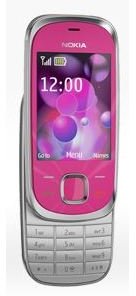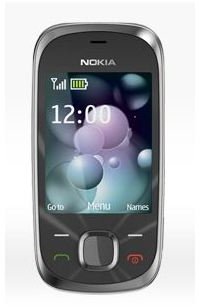Review of the Nokia 7230 Part 1: Introduction and Design
Introduction
Nokia has quite the range of mobile handsets, catering to mostly all the user demographics. The 7230 handset is especially designed to be a low-budget phone with the bare modicum of features to run the handset efficiently.
The Nokia 7230 is not a shabby handset by any means, whether in the appearance or features department. It is merely a pared down version so that it becomes a viable option to people who do not want to spend a great deal of money.
Design (3 out of 5)
With the Nokia 7230, we see the return of the quintessential slider phone – which was much admired for reducing the length of the device, through a marginal increase in the width. The slider phone is also less prone to significant damage as compared to the flip phone.
The Nokia 7230 is a small handset, which fits very snugly in the palm of the user’s hand. It measures 98 by 48 by 14.8 mm, weighing only 100 gm. The edges are rounded, giving the handset the appearance of a smooth pebble. The finishing is glossy, with chrome highlights and detailing along the various sides.
The front is devoted to the 2.4 inch screen, with a resolution of 240 x 320 pixels. The screen size is not too shabby for the device, however it does seem that it could have stood to be slightly bigger as there seems to be excess space around the edges. There is the omnipresent directional pad, flanked on either side by the call manipulation buttons and the two context-sensitive buttons. All the elements are surrounded by a deep chrome bevel sloping into the sides.
When the slider is open, the keypad is revealed. The buttons are large and easy to use, without mistakes. The screen slides into position with a smooth motion instead of the definite click that accompanies most similar features on other devices. The left edge is free of any ports, while the right edge has a dedicated camera key. Both edges are finished in chrome. The user will find the power button on top and the charging point, the microphone jack and the miniUSB port on the bottom edge.
The back panel is simply designed with the camera lens set on one side. There is a slight edge protecting the lens, although it is level with that edge.
The handset is available in one of two colour schemes: hot pink and graphite.
Features (3 out of 5)

The handset’s telephony works like a charm, as Nokia has had plenty of practice with it before. The contacts application is not particularly complex, with the standard fields and personalization options. The font is nicely large for easy readability on the smallish screen. Incoming calls are displayed prominently, and the buttons contribute significantly to easy access of those calls.
The messaging application is again standard, with a straightforward, no-frills interface. Converting a text message into a multimedia one is simply a matter of inserting media into the message. Email, on the other hand, is a tedious and time-consuming application to set up. It takes a very long time to establish a working connection to a webmail service. Fortunately the process does not include plugging in the settings, otherwise the process might have taken even longer. However, the providers on offer are the most popular ones, and more obscure email services will have to be configured from scratch. After the email accounts are set up, the headers take ages to download – in spite of a fast connection. Accessing the body of an email is too tedious to contemplate.
Thankfully the Internet browsing options are certainly more heartening. There are two browsers pre-installed on the device – one is the ever-present, proprietary one by Nokia, and the second is the always excellent Opera Mini. There is no doubt that Opera Mini is one of the best mobile browsers, and it certainly trumps the Nokia one any day.
The camera on the 7230 is far from shabby offering 3.2 megapixel shots. The application does the hardware sufficient justice, as it has a few useful functions. The settings are hardly professional but they are passably workable at a push. The quality of the pictures is fairly good in well lit areas, although the same cannot be said for poorly lit ones. There is no flash, LED or otherwise, and therefore users will have to forego the pleasure of night-time photography. Indoor photography is clear, although it does not remotely approach the clarity achieved outdoors. On the plus side, the camera application has an option to directly upload snaps to the user’s Flickr account, which is a nice touch indeed.
Connectivity options include Bluetooth and a USB cable, although the cable is not standard which is tedious. The audio player is fairly good and transferring music files to and from the device is easy. However the audio quality during playback is less than satisfactory. The video player manages files easily although the screen is too small to truly enjoy anything longer than a 30 second clip. There is no Wi-Fi built into the phone, which is sad but unsurprising. The phone is 3G enabled though, which somewhat makes up for the lack of Wi-Fi – although data bills will mount if the user isn’t careful.
There is no GPS of course, but there is a pre-installed Nokia Maps application which is handy. The directions are not real-time but with a little planning and foresight, the applications does the trick nicely.
User Interface (3 out of 5)
The Nokia 7230 has the Symbian S40 mobile operating system, which is less than spectacular. The operating system is dependable with few bugs, but it lacks a few features like multi-tasking. However, considering the demographic for which this handset is intended, it may not be too much of an issue.
The main menu is unimaginative and basic, with icons for the various functions. One of the context-sensitive buttons brings up a list of recently used programs. Alternatively, the homescreen can be configured to active mode, where commonly used icons are displayed along the bottom edge of the screen.
In short, access to each function is available, but cumbersome because of the clunky design of the menus.
Performance (4 out of 5)
The call quality is very good, with network reception remaining steady in and out of doors. The calls had minimum background disruption and there was barely any white noise. Calls do not get dropped regularly, which is certainly a big plus.
The trouble with performance on this handset comes with the audio output, whether it is musical playback or calls on the loudspeaker.
The battery on the other hand runs for longer than expected. Perhaps that is largely attributable to the fact that there is very little strain on the device in terms of processing. However, it is nevertheless a definite point in the mobile phone’s favour.
The Verdict (3 out of 5)
The Nokia 7230 is a mid-range phone with appropriate features and capabilities. It does not pretend to be a style statement, nor does it aspire to be a smartphone. It is a simple device with a few functions, some of which it handles well.
The phone will appeal to first-time mobile users, if they still exist, and younger teens. The lack of a good audio quality will prove to be a handicap certainly, but as most people have separate music devices, it will not be too serious a consideration.
